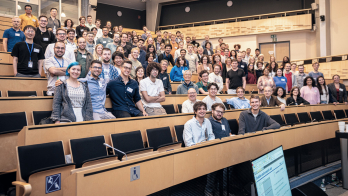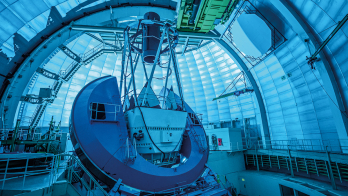Dark matter may constitute 83% of the particles in the universe, but so far there has been no direct observation of its presence in experiments. With its high-energy collisions, the LHC is a promising hunting ground for this elusive form of “matter”, either by producing dark-matter particles directly or new particles that decay into dark matter. Recently, the CMS collaboration completed a search for dark matter, sifting through the full 2011 data set of proton collisions at a centre-of-mass energy of 7 TeV.
Dark-matter particles produced at the LHC would presumably escape undetected, yielding “missing momentum” in the event. However, they could be accompanied by a jet or a photon, or some other particle. CMS has looked for evidence of these visible companions by studying “monojet” and “monophoton” data. Within the framework of a simple model for the production of dark matter, the CMS analysis significantly extends the sensitivity of direct searches, which look for tiny interactions of dark-matter particles in very sensitive detectors.

The way that the dark-matter particles (χ) are produced and interact depends on their spin. With respect to direct searches, CMS is sensitive in the low-mass region below 3.5 GeV if the spin of the produced particles is ignored, and it can set the world’s best limits at all masses in the spin-dependent case.
The monophoton search looks for single, isolated photons (γ) with transverse energy greater than 145 GeV and more than 130 GeV of missing transverse energy. Events with excessive hadronic activity (jets) are vetoed. After the application of selection criteria, 73 events remain, where 71.9 ± 9.1 would be expected in the absence of dark-matter particles. Standard Model background-events are expected mainly from pp → Zγ – where the Z decays to two neutrinos – and from events with misidentified jets or electrons, or from instrumental sources.
The monojet search requires at least one jet with transverse momentum greater than 110 GeV and more than 350 GeV of missing transverse momentum. Events with isolated leptons or more than two jets are vetoed. After event selection, 1142 events are found in data with an expectation from Standard Model processes of 1224 ± 101 events. Again, a contribution from “invisible” decays to neutrinos dominate this expectation, either from pp → Z+jets with the Z decaying to two neutrinos, or from pp → W+jets where the W escapes detection. There seem to be no signs of a new production mechanism for the two “mono-object” signatures analysed, so CMS can use the null results to place limits on the cross-section for dark matter. The limits depend on the presumed mass of the dark-matter particles and are presented as regions in the plane of cross section vs mass in the figures.








